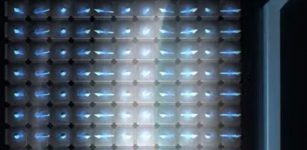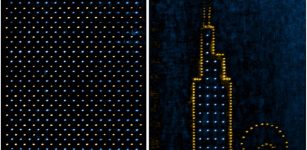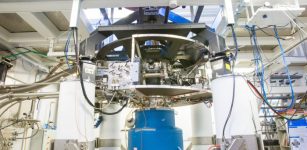New Waveguide Device Protects Photonic Quantum Computers From Errors
Eddie Gonzales Jr. – MessageToEagle.com – Physicists from the University of Rostock, along with researchers from the University of Southern California, the University of Central Florida, Pennsylvania State University, and Washington University in Saint Louis, have developed a new mechanism to protect optical entanglement in quantum photonics.
A judiciously designed arrangement of coupled waveguides allows for partially entangled states of light to be purified (University of Southern California / M. A. Selim).
Declared as International Year of Quantum Science and Technology by the United Nations, 2025 marks 100 years since the initial development of quantum mechanics. As this strange and beautiful description of nature on the smallest scales continues to fascinate and puzzle physicists, its quite tangible implications form the basis of modern technology as well as material science, and are currently in the process of revolutionizing information science and communications.
A key resource to quantum computation is so-called entanglement, which underpins the protocols and algorithms that make quantum computers exponentially more powerful than their classical predecessors. Moreover, entanglement allows for the secure distribution of encryption keys, and entangled photons provide increased sensitivity and noise resilience that dramatically exceed the classical limit.
Yet, entanglement is a delicate property and can easily be lost due to decoherence arising from perturbations such as thermal noise, and reliably preserving the entangled portion of an arbitrary input state is one of the central challenges in quantum technologies.
The team approached this formidable task by harnessing the complex light dynamics in photonic circuits. Placed in close proximity to one another, such “photonic wires” do not only guide light along pre-defined paths, but also allow photons to “jump” between neighboring lanes.
By fine-tuning this coupling to conform to so-called anti-parity-time symmetry, the researchers managed to selectively remove the non-entangled components of arbitrary input states. Implemented on a lossless photonic network, their newly-devised entanglement filter achieves near-unity fidelity under single- and two-photon excitation and is scalable to higher photon levels, remaining robust against decoherence during propagation.
These findings open up a promising path in quantum photonics, eliminating the need for absorbing or amplifying materials. Ultimately, by enabling the on-demand generation of entangled photons and the non-destructive purification of entanglement on a compact optical chip, this work sets the stage for advanced quantum technologies to be developed on integrated platforms.
This research was funded by Deutsche Forschungsgemeinschaft and the Alfried Krupp von Bohlen und Halbach-Foundation.
Their discovery was published in “Science” on March 28, 2025.
Paper – M. A. Selim, M. Ehrhardt et al., “Selective filtering of photonic quantum entanglement via anti-parity-time symmetry,” Science, https://doi.org/10.1126/science.adu3777 (2025).
Written by Eddie Gonzales Jr. – MessageToEagle.com Staff Writer











